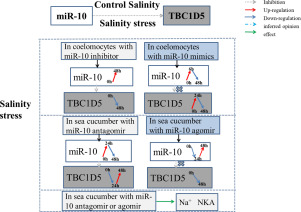当前位置:
X-MOL 学术
›
Comp. Biochem. Physiol. B Biochem. Mol. Biol.
›
论文详情
Our official English website, www.x-mol.net, welcomes your
feedback! (Note: you will need to create a separate account there.)
miR-10 involved in salinity-induced stress responses and targets TBC1D5 in the sea cucumber, Apostichopus japonicas.
Comparative Biochemistry and Physiology B: Biochemistry & Molecular Biology ( IF 1.9 ) Pub Date : 2020-01-02 , DOI: 10.1016/j.cbpb.2019.110406 Yi Tian 1 , Yanpeng Shang 1 , Ran Guo 1 , Jun Ding 1 , Xiaoyu Li 1 , Yaqing Chang 1
Comparative Biochemistry and Physiology B: Biochemistry & Molecular Biology ( IF 1.9 ) Pub Date : 2020-01-02 , DOI: 10.1016/j.cbpb.2019.110406 Yi Tian 1 , Yanpeng Shang 1 , Ran Guo 1 , Jun Ding 1 , Xiaoyu Li 1 , Yaqing Chang 1
Affiliation

|
The sea cucumber is an economically important aquaculture species in China, where it encounter hypo-saline conditions caused by freshwater outflow from rivers and rainfall. MicroRNAs (miRNA) are small noncoding RNAs of about 22 nucleotides, which are crucial regulators of gene expression at the post-transcriptional level and are involved in a variety of physiological and pathophysiological processes. miR-10 is differentially expressed in salinity acclimation, and has a seed-region match with TBC1D5. The expression profiles of miR-10 and TBC1D5 indicate that miR-10 negatively regulates the expression of TBC1D5 in coelomocytes and sea cucumbers with a miR-10 agomir or antagomir. During salinity acclimation, up-regulation of miR-10 was induced after transfection in coelomocytes with a miR-10 inhibitor, while down-regulation of TBC1D5 was induced. The miR-10 expression maximum in coelomocytes appeared at 48 h post-transfection with a miR-10 inhibitor, was later than that of in sea cucumbers, which appeared 24 h after miR-10 antagomir injection. There was no longer a negative relationship between miR-10 and TBC1D5 expression in coelomocytes and sea cucumbers with miR-10 mimics or agomir during salinity acclimation. The miR-10 antagomir or agomir only affected sodium and NKA enzyme activities, and has little effect on other chloride and potassium ions. Our results demonstrate miR-10 directly regulates TBC1D5 by targeting its 3'-UTR, and that miR-10 suppression substantially increases TBC1D5 mRNA levels in vivo and in vitro. Furthermore, miR-10 and TBC1D5 fluctuating expression patterns after treatment with a miR-10 inhibitor or mimics during salinity acclimation may indicate that they are required for adaptation to salinity stress caused by environmental change. Especially, the miR-10 up-regulation in coelomocytes with miR-10 inhibitor during salinity acclimation indicated that they are required for adaptation to salinity stress caused by environmental change. We propose that miR-10 participates in a regulatory circuit that allows for rapid gene program transitions in response to osmotic stress.
更新日期:2020-01-02











































 京公网安备 11010802027423号
京公网安备 11010802027423号